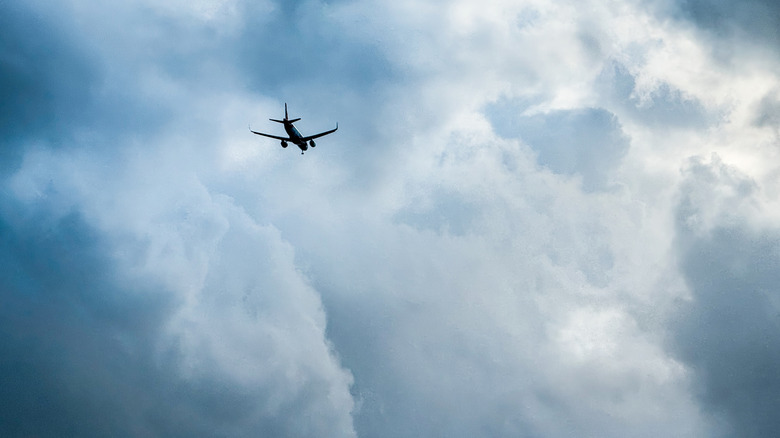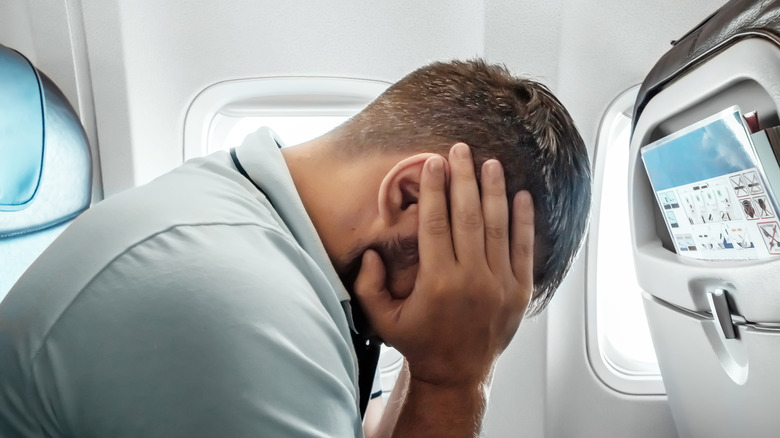A Dangerous In-Flight Phenomenon Is On The Rise Due To Climate Change, And It's Pretty Much Unavoidable
Climate change not only causes boiling summers along with more natural disasters like hurricanes but also increases air turbulence, according to experts. So if you've noticed more and more turbulence during your flights lately, you're right. While turbulence is hardly a reason for plane crashes, it can be unnerving and injure both passengers and crew. To understand turbulence, imagine your plane as Jell-o in a bowl. Now jiggle that Jell-o to simulate a plane in turbulence. No matter how hard you shake the bowl, the plane stays inside of it — just like it will in the sky. However, with enough jostling, even seasoned fliers will break out in a sweat.
There are three main types of turbulence: light, moderate, and severe. All of these but especially severe turbulence increased over the North Atlantic Ocean (one of the world's busiest flight routes) between the years of 1979 and 2020 (per the World Economic Forum). Most troubling is the increase in the most dangerous type of turbulence, known as clear-air turbulence (CAT), which has, in the past, proved difficult to predict. Researchers theorize that unpredictable turbulence is caused by ever-warming air (thanks again, climate change). And experts predict that, by 2050, the frequency of severe clear-air turbulence may be double what it is now. Unfortunately, it doesn't look as if global temperatures will be decreasing any time soon, so expect turbulence to continue increasing — in both frequency and severity.
Pilots can avoid or predict certain types of turbulence, except for CAT, which cannot be seen on radar. Nonetheless, pilots are constantly checking the weather, talking with other planes, and utilizing their experience to ensure the smoothest possible ride for passengers. Outside of the pilots and flight crews, experts are also striving to address the issue by improving the systems and technology for turbulence forecasting, for example by using artificial intelligence and computer simulations of the atmosphere.
What you can do as a passenger in increasingly bumpy skies
Those especially unnerved by turbulence can also make certain decisions before flying to lower the possibility that turbulence will occur and ease discomfort when it's unavoidable. Air passengers with a serious fear of flying prefer one particular airline carrier over all the others: JetBlue, which offers an abundance of in-flight entertainment options to distract people from constant worrying. But whatever airline you choose, select seats at the front of the plane if possible, where any jolts that occur will be less dramatic. Seats over the wings are also more stable, as the wings are the plane's shock absorbers. Early morning and late evening are the best times to book flights for anxious fliers who hate turbulence. Planes that depart during these times tend to fly through cooler air and weaker winds and encounter fewer storms. A few other factors can affect turbulence but may be less under your control. For one, the size of the aircraft can impact its ability to withstand turbulence, with smaller planes being more vulnerable than larger ones. The path the pilot takes to your destination is also a critical factor. Routes that pass over mountains, for example, tend to be more turbulent.
When turbulence does strike, listen to the flight crew and keep your seatbelt on — even when the fasten seatbelt sign isn't lit. Most people who are injured during turbulence are not wearing their seatbelts, after all. Also, keep your belongings stowed away to prevent things from flying around the cabin. And make sure those overhead bins are securely shut! Finally, to calm your jitters before or during a flight, take advantage of this amazing app, which is a game-changer for nervous fliers who hate turbulence.

